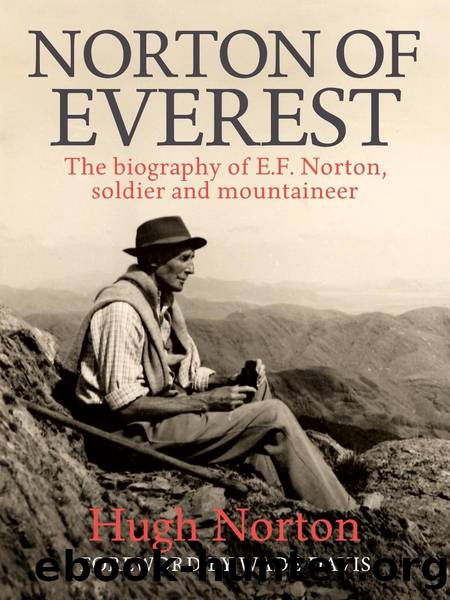Norton of Everest by Hugh Norton

Author:Hugh Norton [Hugh Norton]
Language: eng
Format: epub
ISBN: 9781910240939
Publisher: Vertebrate Publishing
Published: 2017-01-15T00:00:00+00:00
So ended his epic climb. Together the two climbers crept down the mountain by the afternoon light and then in the gathering dusk, aiming for Camp IV where a support party awaited them. To reach it took them seven and a half hours in all. At the end, their approach to the North Col was in complete darkness and by torchlight. A little higher up, shortly after sunset, a final drama had taken place. Somervellâs cough and swollen larynx became so bad that he sat down, completely unable to breathe and believing himself at the point of death, while his companion, unaware of his predicament, hurried on down towards the camp. Eventually Somervell was able to clear the obstruction in his throat, coughing up a part of his throat lining together with the obstruction, and they both reached the camp safely.
During the night, Teddy, who earlier in the day had removed his snow goggles because he couldnât see his footing clearly, was struck by painful snow blindness. He remained unable to see, and in acute pain, for three days, at the end of which, though his sight was restored, the expedition doctor told him that his heart was dilated â âpretty rottenâ, the diary comments.
It is worth pausing to reflect on his achievement. He had reached, without using oxygen, an altitude, within 1,000 feet of the top of Everest, that was not exceeded anywhere by any other oxygen-less climber for fifty-four years, though in 1933 Wager, Wyn Harris and Smythe reached approximately the same height. George Mallory and Sandy Irvine may have â it is not certain â exceeded this altitude in 1924, but using oxygen. Not until 1978 was his altitude record without oxygen exceeded, and Everest climbed without oxygen to the summit, by Reinhold Messner and Peter Habeler. Summiting Everest without oxygen remains to this day an unusual accomplishment.
Specialists in high-altitude physiology have admired his achievement. The distinguished physiologist, and Himalayan climber, John West, in his book High Life â a History of High-Altitude Physiology and Medicine, cites Teddyâs performance as outstanding within its time frame, and believes that survival at these altitudes without supplementary oxygen is clearly at the absolute limit of human capabilities. He discusses in his book whether top performers at high altitudes have unusual physical characteristics, but concludes âthat elite extreme-altitude climbers do not have readily identifiable physiological adaptations that can explain their unique performance. Exceptional motivation, and an incredible obsession to succeed, may be more important factors.â
Reflecting perhaps the same conclusion, Somervell, in a letter to Teddyâs widow many years later, commented that:
âHe was not the right physique for a long climb, being tall and spare â but he simply made himself do it with his strong and valiant mind, and got higher than anyone else though several including myself were of tougher build, and we all were failures by the side of Teddy who had more âgutsâ than any of us.â
Download
This site does not store any files on its server. We only index and link to content provided by other sites. Please contact the content providers to delete copyright contents if any and email us, we'll remove relevant links or contents immediately.
China Rich Girlfriend by Kwan Kevin(4253)
The Silk Roads by Peter Frankopan(4241)
Annapurna by Maurice Herzog(3272)
Full Circle by Michael Palin(3245)
Hot Thai Kitchen by Pailin Chongchitnant(3180)
Okonomiyaki: Japanese Comfort Food by Saito Yoshio(2608)
The Ogre by Doug Scott(2479)
City of Djinns: a year in Delhi by William Dalrymple(2414)
Photographic Guide to the Birds of Indonesia by Strange Morten;(2382)
Vietnam, Cambodia, Laos & Northern Thailand by Lonely Planet(2296)
Tokyo by Rob Goss(2275)
Tokyo Geek's Guide: Manga, Anime, Gaming, Cosplay, Toys, Idols & More - The Ultimate Guide to Japan's Otaku Culture by Simone Gianni(2218)
Everest the Cruel Way by Joe Tasker(2112)
Discover China Travel Guide by Lonely Planet(2092)
Iranian Rappers And Persian Porn by Maslin Jamie(2072)
China (Lonely Planet, 11th Edition)(2017)
Lonely Planet China(2005)
China Travel Guide by Lonely Planet(1974)
Top 10 Dubai and Abu Dhabi by DK Travel(1965)
